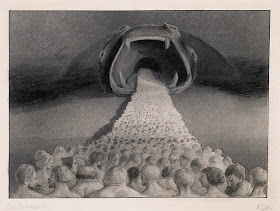As he later recalled, “her familiar face suddenly turned pinched and alien.” He added that over the course of his life, “I often stood at deathbeds, but what I saw there could no longer influence the impression of that first death.” Further complicating his fragile mental state, Kubin was seduced at 11 by a pregnant woman.At 19, he attempted suicide on his mother's grave. He and his father fought bitterly over money and his future. His Oedipal animosities toward his father appear in many of his works, and he always depicted fathers and sons as enemies. His military service ended with a "nervous breakdown," from which he spent a year recovering. In 1898 his family, not knowing what else to do with him, sent him to study art. After a brief stint at a private academy run by the painter Ludwig Schmitt-Reutte, he enrolled at the Munich Academy in 1899. Above, Eternal Flame, 1902. Wikipedia:
In Munich, Kubin discovered the works of Odilon Redon, Edvard Munch, James Ensor, Henry de Groux and Félicien Rops. He was profoundly affected by the prints of Max Klinger, and later recounted: "Here a new art was thrown open to me, which offered free play for the imaginative expression of every conceivable world of feeling. Before putting the engravings away I swore that I would dedicate my life to the creation of similar works."Kubin's psychological and mythic obsessions were a perfect fit for the Munich art scene of the early 1900s, and by 1902 he was exhibiting in major galleries. In this time he experienced one of those productive bursts that characterize some mentally unstable artists, channeling his neuroses into weirdly wonderful and strangely terrible drawings. These are the works of his I like best, all in black and white or sepia, all horrifying, mad, or both. Above, Mythical Beast, 1905.
In 1909 Kubin's first wife died and he poured his grief into a strange novel called The Other Side. The narrator and his wife are invited by a reclusive billionaire to join a "perfect" community he is building behind a massive wall with only one gate. In this world the sky is always gray and money changes value from moment to moment, and nothing is ever quite what it seems. Above, (The North Pole, 1902.) From a summary of the novel:
...At this point a strange American turns up in Perle and begins loudly to announce that he intends to challenge its ineffective leader for the privilege of governing the Dream Kingdom. From here on in, things begin to get truly weird. The town is tormented by plagues of animals and insects, buildings collapse and earthquakes swallow people alive. Eventually the whole place is destroyed in a number of scenes which resemble the worst excesses of the Book of Revelation crossed with the fever dream of an insane depressive.Kubin remained part of the avant garde scene until about 1913, when he moved permanently to a small castle he had acquired in the Austrian town of Zwickledt. He continued to work, but at a much lower rate, and I don't like those works nearly as much. The Nazis declared his work "degenerate" but otherwise left him alone. After the war he was lionized for a time as a surviving anti-Nazi artist who never knuckled under. Above, Household Linden, 1903.
An amusing note from a good, brief biography: "A lifelong hypochondriac, Kubin died at the healthy age of 82, in 1959." Above, Earth, Mother of Us All.
The Lady on the Horse, 1901.
Untitled, 1900-1903. (Often called The Eternal Flame, but not titled by Kubin.)
The Last King, 1902-1903.
Every Night a Dream Visits Us, 1904.
Into the Unknown, 1901.
More Kubin here, including pictures not appropriate for this blog.












I always skim through your blog and end up on a wild tangent about one topic or another. Rarely I find something that speaks to the very core of myself. I have a love or art and history, but I was NEVER introduced to Kubin until today. Thanks for posting this, it drawled me in.
ReplyDelete